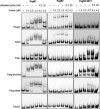Overlapping and Distinct Functions of the Paralogous PagR Regulators of Bacillus anthracis
- PMID: 36005808
- PMCID: PMC9487532
- DOI: 10.1128/jb.00208-22
Overlapping and Distinct Functions of the Paralogous PagR Regulators of Bacillus anthracis
Abstract
The Bacillus anthracis pagA gene, encoding the protective antigen component of anthrax toxin, is part of a bicistronic operon on pXO1 that codes for its own repressor, PagR1. In addition to the pagAR1 operon, PagR1 regulates sap and eag, two chromosome genes encoding components of the surface layer, a mounting structure for surface proteins involved in virulence. Genomic studies have revealed a PagR1 paralog, PagR2, encoded by a gene on pXO2. The amino acid sequences of the paralogues are 71% identical and show similarity to the ArsR family of transcription regulators. We determined that the expression of either rPagR1 or rPagR2 in a ΔpagR1 pXO1+/pXO2- (PagR1-PagR2) background repressed the expression of pagA, sap, eag, and a newly discovered target, atxA, encoding virulence activator AtxA. Despite the redundancy in PagR1 and PagR2 function, we determined that purified rPagR1 bound DNA corresponding to the control regions of all four target genes and existed as a dimer in cell lysates, whereas rPagR2 exhibited weak binding to the DNA of the pagA and atxA promoters, did not bind sap or eag promoter DNA, and did not appear as a dimer in cell lysates. A single amino acid change in PagR2, S81Y, designed to match the native Y81 of PagR1, allowed for DNA-binding to the sap and eag promoters. Moreover, the S81Y mutation allowed for the detection of PagR2 homomultimers in coaffinity purification experiments. Our results expand our knowledge of the roles of the paralogues in B. anthracis gene expression and provide a potential mechanistic basis for differences in the functions of these repressors. IMPORTANCE The protective antigen component of the anthrax toxin is essential for the delivery of the enzymatic components of the toxin into host target cells. The toxin genes and other virulence genes of B. anthracis are regulated by multiple trans-acting regulators that respond to a variety of host-related signals. PagR1, one such trans-acting regulator, connects the regulation of plasmid-encoded and chromosome-encoded virulence genes by controlling both protective antigen and surface layer protein expression. Whether PagR2, a paralog of PagR1, also functions as a trans-acting regulator was unknown. This work advances our knowledge of the complex model of virulence regulation in B. anthracis and furthers our understanding of the intriguing evolution of this pathogen.
Keywords: ArsR family; Bacillus anthracis; anthrax toxin; paralogous proteins; regulatory paralogs; transcriptional regulation.
Conflict of interest statement
The authors declare no conflict of interest.
Figures







Similar articles
-
Bacillus anthracis Virulence Regulator AtxA Binds Specifically to the pagA Promoter Region.J Bacteriol. 2019 Nov 5;201(23):e00569-19. doi: 10.1128/JB.00569-19. Print 2019 Dec 1. J Bacteriol. 2019. PMID: 31570528 Free PMC article.
-
In vivo Bacillus anthracis gene expression requires PagR as an intermediate effector of the AtxA signalling cascade.Int J Med Microbiol. 2004 Apr;293(7-8):619-24. doi: 10.1078/1438-4221-00306. Int J Med Microbiol. 2004. PMID: 15149039 Review.
-
Structural and Functional Analysis of Toxin and Small RNA Gene Promoter Regions in Bacillus anthracis.J Bacteriol. 2022 Sep 20;204(9):e0020022. doi: 10.1128/jb.00200-22. Epub 2022 Aug 31. J Bacteriol. 2022. PMID: 36043862 Free PMC article.
-
Bacillus anthracis genetics and virulence gene regulation.Curr Top Microbiol Immunol. 2002;271:143-64. doi: 10.1007/978-3-662-05767-4_7. Curr Top Microbiol Immunol. 2002. PMID: 12224521 Review.
-
Autogenous regulation of the Bacillus anthracis pag operon.J Bacteriol. 1999 Aug;181(15):4485-92. doi: 10.1128/JB.181.15.4485-4492.1999. J Bacteriol. 1999. PMID: 10419943 Free PMC article.
Cited by
-
Impact of a Novel PagR-like Transcriptional Regulator on Cereulide Toxin Synthesis in Emetic Bacillus cereus.Int J Mol Sci. 2022 Sep 29;23(19):11479. doi: 10.3390/ijms231911479. Int J Mol Sci. 2022. PMID: 36232797 Free PMC article.
References
-
- Fortuna A, Bähre H, Visca P, Rampioni G, Leoni L. 2021. The two Pseudomonas aeruginosa DksA stringent response proteins are largely interchangeable at the whole transcriptome level and in the control of virulence-related traits. Environ Microbiol 23:5487–5504. 10.1111/1462-2920.15693. - DOI - PubMed
Publication types
MeSH terms
Substances
Grants and funding
LinkOut - more resources
Full Text Sources
Miscellaneous

